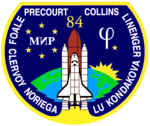STS-84
| Mission emblem | |||
|---|---|---|---|

|
|||
| Mission dates | |||
| Mission: | STS-84 | ||
| COSPAR-ID : | 1997-023A | ||
| Crew: | 7th | ||
| Begin: | May 15, 1997, 08:07:48 UTC | ||
| Starting place: | Kennedy Space Center , LC-39A | ||
| Space station: | Me | ||
| Coupling: | May 17, 1997, 02:33:20 UTC | ||
| Decoupling: | May 22, 1997, 01:03:56 UTC | ||
| Duration on me: | 4d 22h 30m 36s | ||
| Landing: | May 24, 1997, 13:27:44 UTC | ||
| Landing place: | Kennedy Space Center, Lane 33 | ||
| Flight duration: | 9d 5h 19m 56s | ||
| Earth orbits: | 145 | ||
| Track height: | approx. 296 km | ||
| Covered track: | 5.8 million km | ||
| Team photo | |||
 v. l. No. Jean-Francois Clervoy, Jerry Linenger, Eileen Collins, Charles Precourt, Edward Tsang Lu, Michael Foale, Jelena Kondakowa, Carlos Noriega |
|||
| ◄ Before / After ► | |||
|
|||
STS-84 ( English S pace T ransportation S ystem) is a mission designation for the US space shuttle Atlantis ( OV -104) of NASA . The launch took place on May 15, 1997. It was the 84th space shuttle mission, the 19th flight of the space shuttle Atlantis, the eighth flight as part of the Shuttle Mir program and the 6th coupling of a US space shuttle to the Space station Mir .
team
Shuttle crew
- Charles Precourt (3rd space flight), commander
- Eileen Collins (2nd space flight), pilot
- Carlos Noriega (1st spaceflight), mission specialist
- Edward Lu (1st spaceflight), mission specialist
-
Jean-François Clervoy (2nd space flight), Mission Specialist ( ESA / France )


-
Jelena Kondakowa (2nd space flight), mission specialist ( Roskosmos / Russia )

Me crew outbound
- Michael Foale (4th space flight)
replacement
- James Voss for Foale
Me crew return flight
- Jerry Linenger (2nd space flight)
(Returned to Earth after a flight time of 132 days, 4 hours and 1 minute; one-way flight with STS-81 )
Mission description
The main tasks of the 6th Mir Docking Mission were material and crew transport. Michael Foale took over the regular place in the station from Jerry Linenger, who returned to earth after a four-month flight with the Atlantis. Also on board was a Spacehab double module in which various biological experiments were carried out with the Biorack. The biorack contained several chambers and centrifuges in which different gravity forces could be simulated. The effects of weightlessness and cosmic rays on plant roots , protozoa and white blood cells were examined . A special radiation monitor records the strength of the incident cosmic radiation over the entire duration of the flight.
The experiments with the biorack continued after the space shuttle was coupled to the station. In the first few days, the commander and pilot were exclusively occupied with the approach maneuver. After commissioning and testing the navigation systems, an additional camera was installed that must be precisely aligned with the target cross in the coupling adapter of the space station . The manual docking worked as planned, 42 hours after the start.
The main task during the joint flight was the transport of 249 objects between the two spacecraft. This mainly included drinking water, equipment and research material. A protein crystal growing unit was transported to the Atlantis, while a new oxygen generator was brought on board the station in the opposite direction . During the mission, a series of photos was taken of the station, which should allow statements about its condition after ten years of flight. Air and water samples were also taken in the station, which were later analyzed on earth. Various interviews and video conferences provided short breaks. In particular, Michael Foale, who is of British descent, and Carlos Noriega, who was born in Peru, were in demand. An ESA astronaut and a Russian space traveler were also on board the Atlantis.
Jerry Linenger and Michael Foale arranged the handover modalities. Linenger returned to Earth with the Atlantis after 132 days on board the Mir space station . Michael Foale, who was familiarized with the station by his Russian colleagues Tsiblijew and Lasutkin, took over his place in the Spectrum module.
Various stress tests were carried out during the joint flight of Atlantis and Mir. By igniting the maneuvering engines of the shuttle or the space station, the coupling adapters and the solar cell surfaces in particular are exposed to great loads. The stability of these structures was measured under various conditions. These investigations should also allow conclusions to be drawn about the stability of the future International Space Station ISS.
After five days of strenuous work, the hatches were closed and the Atlantis disconnected from the Mir space station. A spring mechanism pushed the two spacecraft about half a meter apart before the space shuttle's control engines could be ignited. A laser-based approach system developed by ESA was tested for stopovers at distances of 30, 100, 500 and 1,000 meters . It can be used to obtain precise data on distance and relative speed. The usual flying around the station was thus omitted this time. While astronaut Linenger trained his muscles on the treadmill, his colleagues prepared everything for the return. All equipment was secured, the systems of the Spacehab switched off and the navigation devices tested. Since all tests were successful, the Atlantis landed on Cape Canaveral after a nine-day flight .
See also
Web links
- NASA Mission overview (English)
- Video summary with comments of the crew (English)
- NASA video of Mission (English)

